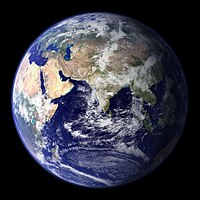Sejarah geologi Bumi: Perbedaan antara revisi
Add 1 book for Wikipedia:Pemastian (20210209)) #IABot (v2.0.8) (GreenC bot |
Rescuing 2 sources and tagging 0 as dead.) #IABot (v2.0.8 |
||
| Baris 24: | Baris 24: | ||
== Pranala luar == |
== Pranala luar == |
||
* [http://www.tufts.edu/as/wright_center/cosmic_evolution/docs/splash.html Cosmic Evolution] — a detailed look at events from the origin of the universe to the present |
* [http://www.tufts.edu/as/wright_center/cosmic_evolution/docs/splash.html Cosmic Evolution] {{Webarchive|url=https://www.webcitation.org/5QVjwZCzJ?url=http://www.tufts.edu/as/wright_center/cosmic_evolution/docs/splash.html |date=2007-07-22 }} — a detailed look at events from the origin of the universe to the present |
||
* Valley, John W. "[http://www.sciam.com/article.cfm?chanID=sa006&colID=1&articleID=0005FA5D-5F7C-1333-9F7C83414B7F0000 A Cool Early Earth?]" ''[[Scientific American]]''. 2005 Oct:58–65. – discusses the timing of the formation of the oceans and other major events in Earth’s early history. |
* Valley, John W. "[http://www.sciam.com/article.cfm?chanID=sa006&colID=1&articleID=0005FA5D-5F7C-1333-9F7C83414B7F0000 A Cool Early Earth?]" ''[[Scientific American]]''. 2005 Oct:58–65. – discusses the timing of the formation of the oceans and other major events in Earth’s early history. |
||
* [[Paul Davies|Davies, Paul]]. "[http://www.guardian.co.uk/science/story/0,3605,1671164,00.html Quantum leap of life]". ''[[The Guardian]]''. 2005 Dec 20. – discusses speculation into the role of quantum systems in the origin of life |
* [[Paul Davies|Davies, Paul]]. "[http://www.guardian.co.uk/science/story/0,3605,1671164,00.html Quantum leap of life]". ''[[The Guardian]]''. 2005 Dec 20. – discusses speculation into the role of quantum systems in the origin of life |
||
* [http://www.johnkyrk.com/evolution.html Evolution timeline] (uses [[Adobe Shockwave|Shockwave]]). Animated story of life since about 13,700,000,000 shows everything from the big bang to the formation of the earth and the development of bacteria and other organisms to the ascent of man. |
* [http://www.johnkyrk.com/evolution.html Evolution timeline] (uses [[Adobe Shockwave|Shockwave]]). Animated story of life since about 13,700,000,000 shows everything from the big bang to the formation of the earth and the development of bacteria and other organisms to the ascent of man. |
||
* [http://cosmographica.com/gallery/portfolio2007/content/442_CoolEarlyEarth_large.html Artist's Conception of Cold Early Earth] |
* [http://cosmographica.com/gallery/portfolio2007/content/442_CoolEarlyEarth_large.html Artist's Conception of Cold Early Earth] |
||
* [http://www.uwmc.uwc.edu/geography/hutton/hutton.htm Theory of the Earth & Abstract of the Theory of the Earth] |
* [http://www.uwmc.uwc.edu/geography/hutton/hutton.htm Theory of the Earth & Abstract of the Theory of the Earth] {{Webarchive|url=https://web.archive.org/web/20030729055405/http://www.uwmc.uwc.edu/geography/Hutton/Hutton.htm |date=2003-07-29 }} |
||
* [http://issuu.com/sergioluisdasilva/docs/paleomaps_mollweide_longitude_0 Paleomaps Since 600 Ma (Mollweide Projection, Longitude 0)] |
* [http://issuu.com/sergioluisdasilva/docs/paleomaps_mollweide_longitude_0 Paleomaps Since 600 Ma (Mollweide Projection, Longitude 0)] |
||
* [http://issuu.com/sergioluisdasilva/docs/paleomaps_mollweide_longitude_180 Paleomaps Since 600 Ma (Mollweide Projection, Longitude 180)] |
* [http://issuu.com/sergioluisdasilva/docs/paleomaps_mollweide_longitude_180 Paleomaps Since 600 Ma (Mollweide Projection, Longitude 180)] |
||
Revisi per 7 Maret 2021 04.48

Sejarah geologi Bumi meliputi peristiwa besar yang terjadi di Bumi pada masa lalu sesuai dengan skala waktu geologi, sistem pengukuran kronologis berdasarkan penelitian terhadap lapisan batuan planet (stratigrafi). Bumi terbentuk sekitar 4,54 miliar tahun yang lalu akibat akresi nebula surya, massa berbentuk cakram debu dan gas yang merupakan sisa-sisa dari pembentukan matahari, yang juga menciptakan seluruh Tata Surya.
Permukaan Bumi pada awalnya meleleh akibat aktivitas vulkanisme ekstrem dan sering bertabrakan dengan benda langit lainnya. Pada akhirnya, lapisan luar planet ini mendingin dan mengeras, yang kemudian membentuk kerak padat setelah uap air mulai terkumpul di atmosfer. Bulan terbentuk tak lama setelah pembentukan Bumi, diduga akibat terjadinya tabrakan antara benda langit seukuran Mars dengan Bumi, yang menyebabkan beberapa massa benda langit ini menyatu dengan Bumi dan secara signifikan mengubah komposisi internal Bumi. Akibat tabrakan ini, sebagian materi Bumi terlepas ke luar angkasa, yang pada akhirnya membentuk Bulan. Pelepasan gas dan aktivitas vulkanis menciptakan atmosfer primordial. Kondensasi uap air, dipadukan dengan es yang berasal dari komet dan asteroid, menciptakan lautan.[1]
Permukaan Bumi terus mengalami proses pembentukan kembali selama ratusan juta tahun. Akibatnya, benua terbentuk dan terbelah berulang kali. Benua bergerak di seluruh permukaan Bumi dan bergabung untuk membentuk superbenua. Sekitar 750 juta tahun silam, superbenua paling awal yang diketahui, Rodinia, mulai terpisah. Benua yang terpisah ini kemudian membentuk Pannotia, 600 juta tahun silam, dan pada akhirnya membentuk Pangaea, yang kemudian terpisah lagi 180 juta tahun silam.[2]
Zaman es dimulai sekitar 40 juta tahun silam, dan kemudian mencapai puncaknya pada akhir Pliosen. Wilayah kutub telah mengalami siklus glasiasi dan pencairan es berulang kali, yang berulang setiap 40.000-100.000 tahun. Periode glasial terakhir pada zaman es berakhir sekitar 10.000 tahun yang lalu.[3]
Referensi
- ^ Morbidelli, A.; et al. (2000). "Source regions and time scales for the delivery of water to Earth". Meteoritics & Planetary Science. 35 (6): 1309–1320. Bibcode:2000M&PS...35.1309M. doi:10.1111/j.1945-5100.2000.tb01518.x.
- ^ Murphy, J. B.; Nance, R. D. (1965). "How do supercontinents assemble?". American Scientist. 92 (4): 324–33. doi:10.1511/2004.4.324. Diakses tanggal 2007-03-05.
- ^ Staff. "Paleoclimatology – The Study of Ancient Climates". Page Paleontology Science Center. Diakses tanggal 2007-03-02.
Bacaan lanjutan
- Stanley, Steven M. (1999). Earth system history (edisi ke-New). New York: W. H. Freeman. ISBN 978-0-7167-3377-5.
Pranala luar
- Cosmic Evolution Diarsipkan 2007-07-22 di WebCite — a detailed look at events from the origin of the universe to the present
- Valley, John W. "A Cool Early Earth?" Scientific American. 2005 Oct:58–65. – discusses the timing of the formation of the oceans and other major events in Earth’s early history.
- Davies, Paul. "Quantum leap of life". The Guardian. 2005 Dec 20. – discusses speculation into the role of quantum systems in the origin of life
- Evolution timeline (uses Shockwave). Animated story of life since about 13,700,000,000 shows everything from the big bang to the formation of the earth and the development of bacteria and other organisms to the ascent of man.
- Artist's Conception of Cold Early Earth
- Theory of the Earth & Abstract of the Theory of the Earth Diarsipkan 2003-07-29 di Wayback Machine.
- Paleomaps Since 600 Ma (Mollweide Projection, Longitude 0)
- Paleomaps Since 600 Ma (Mollweide Projection, Longitude 180)

